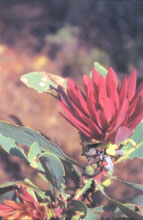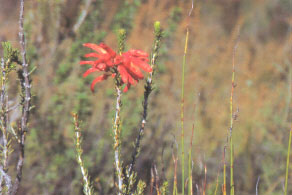Sitting at home in a small settlement at the foot of the mountains near Diba, Saeed told me he inherited his profession from his father, a famous man who was
considered to be doctor in his time. He said, "Most of the people who used to practice this profession died of old age, and some left it when hospitals and modern
health facilities emerged in this country, because a lot of people stopped coming to them." Saeed still practices this profession; not as a means of income, but he is
keen to keep the knowledge he inherited alive and hates to see it coming to an end.
When we say medicinal herbs, this does not only mean treating with herbs. There
are a few other methods or ways of treatment that are related to herbs, but one can say the link is not a direct one.
 There are around 50 different medicinal herbs in the UAE, plus the different big trees. Saeed told me there is a use for each
plant you see, whether it is a tiny single plant or a clump of bush. He showed me some of the most important herbs and explained how they are used.
There are around 50 different medicinal herbs in the UAE, plus the different big trees. Saeed told me there is a use for each
plant you see, whether it is a tiny single plant or a clump of bush. He showed me some of the most important herbs and explained how they are used.
For example, a local plant known as Al Shekaa is a thorny, medium-sized bush that grows after the second rainfall and is used for stomach pain and diarrhea. Saeed said he takes the
leaves and hammers them until they are very well mashed, then boils them in hot water for few minutes only. After that he uses a sieve to remove the leaves and when the patient
drinks this water, the results are very effective and can be felt in less than 30 minutes.
Another plant known as Al Jeidaa is used for fever and body ache related to colds.
The same method of preparation is used as with the Al Shekaa, but the patient has to drink this water after the Fajar prayer (which is around an hour before sunrise),
then go back to sleep. When he wakes up he will be totally fine and well.
For a common sickness, most people in the past knew what herb they should take
for treatment, but still they sought advice from an expert like Saeed, who said, "I must see the patient and diagnose his sickness from my experience, before telling
him what to take. Sometimes I come across something very different and rather complicated; in this case I have to do some research and know what combination
will work best." For example, he continued, "I came across a rare case when a man came to me and told me one of his family had a problem - his stomach had swollen a
lot and he had no energy to move or work. He tried some local doctors, but the result was not very promising." Saeed went off and diagnosed the source of his
illness. He explained, "I came back and gave this matter a lot of thought; at the end I had the remedy, which was rather unusual. I took a combination of 31
different herbs, placed them in a big pot and boiled them for 30 minutes. Then I added seven stones to the mix. After that I took a wooden plank and placed it on
the top of the boiling pot. We helped the patient to sit on the wooden plank and covered him with lots of blankets. He complained that it was too hot and was
feeling pain, but this is normal and we encouraged him to hold on. I repeated the process three times, and believe it or not he was cured!" Saeed told me, "I do not
want you to think I can do magic. I play my part with honesty and the rest lies in the hand of our mighty God."
A common thing in the past was to be bitten by a snake or scorpion. What is the
remedy in such a case? Saeed replied, "Say you got bitten on the ankle. The first thing is to make a small cut where the bite is, then tighten a rope very firmly below
the knee. The next step is to get a piece of Ramram (a small tree that survives all year round), mash the Ramram and apply the paste to the bite. Then you take a
glass of milk mixed with butter and salt. Drinking this mix makes you vomit - not only what you have inside your stomach, but you vomit the venom too. After three days
you will feel fine." Saeed is a strong believer in his profession and is not convinced by the new medicine. He's never used anything but herbs. He told me that only last
month his grandson was bitten by snake. His family could not get hold of him, so they took the boy to the hospital. He stayed 14 days before being totally cured.
Saeed told me that if he had treated him, the boy would have recovered in three days.
A very common herb, known locally as Al Handal is used for hemorrhoids. How the
treatment is performed is very interesting. Handal is a small bush. The plant is cut in two halves, and each half is placed under each foot for one night. The patient
will feel a lot of pain, but in the morning he will go to the toilet and there will be urine in his blood. This is an excellent cure and still used today.
"We also have an ideal treatment for diabetic people that's very simple", continues Saeed. "We give them Khanaseer, a plant that grows after the rain. All they have
to do is to eat the plant as it is; it helps a lot. This plant is becoming more rare now because of the drought, but I managed to grow it in my garden very successfully. I
tasted the plant and it had a very light bitter taste. This plant is also used for treating burns by placing the crushed leaves on the burnt area".
One advantage of using herbs is that the patient does not have to be on a particular diet, he can eat what he wants.
 Medicinal herbs are a world of their own. There seems to be a treatment for everything, including broken bones. The plant Al Dhafir is crushed, and mixed with
goat hair, Shekaa and eggs. It is used instead of the modern gypsum cast. A wooden stick is placed to straighten the broken bone properly, then this mix is
applied on top. The advantage of this cast is that it breaks when the bone is healed. To help the healing, the plant Seraow is used by crushing its leaves, boiling them and drinking the liquid.
Medicinal herbs are a world of their own. There seems to be a treatment for everything, including broken bones. The plant Al Dhafir is crushed, and mixed with
goat hair, Shekaa and eggs. It is used instead of the modern gypsum cast. A wooden stick is placed to straighten the broken bone properly, then this mix is
applied on top. The advantage of this cast is that it breaks when the bone is healed. To help the healing, the plant Seraow is used by crushing its leaves, boiling them and drinking the liquid.
There is also something for delivery. If the woman is suffering pain and has a problem delivering the baby, we use a plant known locally as Almarkh, which is very
well crushed and mixed with water. She drinks the water and within two hours she will deliver the baby with ease, and not a lot of pain.
Saeed is proud because he gets called on by a lot of people asking for the help of his treatment. Obviously, he is very good at his profession, and this is why people
seek his help from as far afield as Fujairah, Ras Al Khaimah, Sharjah, Dubai and even sometimes from Oman.
Most of the herbs grow in the winter months and after the rain. The herbs are
collected and used when they are fresh, but a sufficient stock is dried and stored for use throughout the year, or in case of drought. The herb bushes never die, and
even though they may look to you like a bunch of dried vegetation, the seeds can survive for more than five years, and when it rains they bloom very quickly.
In the past, collecting herbs was a task in itself; a lot of time and hard work was expended on long journeys done on foot and using donkeys. But today it is a lot
easier and faster because of modern transportation.
Saeed briefly mentioned other methods of treatment that do not involve herbs,
known as Al Wasim. This method is very old, and basically it is treating by burning a very small place in the body. The burning tool is made out of metal in the shape of
shape the letter "I". One end has a pointed flat tip, the other end is shaped like a rough square. Al Wasim is used for many different ailments and its practice is very
complicated. The source of the illness has to be carefully diagnosed, and when burning only an expert can pin-point the area. For example, for a permanent
headache, the burning area will be in the middle of the head, but for eye disease the burning area is in the upper side of the arm. Some cases may require more than one
burn, and there are different positions the body has to be in when burning; sometimes standing up, sometimes sitting or lying down. This method may sound
too harsh and can put people off, but even in the past it was only used as a last resort when herbs did not do the trick.
Medicinal herbs were ignored for sometime after the United Arab Emirates boomed,
and people turned toward modern treatment. That was until recently, when His Highness Sheikh Zayed Bin Sultan Al Nahyan, in a wise move to preserve the culture
and heritage of the country, established a medicinal herb centre in Abu Dhabi. One of its aims is to study the herbs, their use, and to conduct research to put those
herbs into more effective use. But people like Saeed still believe that more can be done, and they are always willing to share their secrets and knowledge with anyone who shows interest.
Saeed made yet another interesting point. He said that if I look carefully, each area or region has its own herbs for treatment of illness that occur in the area. For
example, in Africa medicinal herbs are very widely practiced to this day, and they have a lot of different illnesses that we do not have here, with their own herbs for
treatment. Every soil gives you a cure, but you have to work hard to get the result. Nothing comes easy, and to be successful in this profession it has to come from
inside you. It is not something you can learn very quickly, and if you do not believe it works do not go near it.
Lately, it has become a trend to use natural medicines, by producing extract from
certain herbs and avoiding the usage of any chemicals; but this applies to certain medications, not all.
The question remains; are medicinal herbs really effective and can they cure
successfully? Or is part of the treatment purely psychological?
